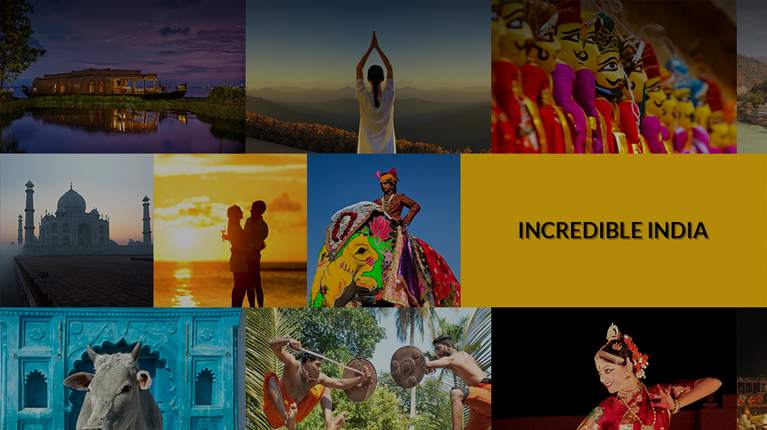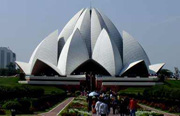


Duration : 13 Nights & 14 Days
Destination Covered : Delhi - Agra - Gwalior - Orchha - Bhopal - Indore - Mandu - Maheshwar - Omkareshwar - Aurangabad - Mumbai
Tour Itinerary
Day 01 Delhi
Arrival at the International airport. You will be received by our representative and transferred to the hotel. Rest of the day at leisure.
Overnight Hotel - Delhi.
Day 02 Delhi
Today we take a guided tour of Old Delhi, the 17th century walled city of Shah Jahanabad, visiting the great Jama Masjid, the principal mosque of Old Delhi. Built in the year 1656 AD by the Mughal Emperor Shah Jahan, it is the largest & best known mosque in India. Later we walk down or take a rickshaw ride through Chandni Chowk, the old marketplace of Shah Jahanabad now a picturesque bazaar to reach Red Fort, built in the year 1648 by Shah Jehan.
In New Delhi, we visit Raj Ghat, memorial to the Father of the Nation, Mahatma Gandhi. It is a simple black marble platform that marks the spot of his cremation on 31 January 1948. Further we drive past India Gate, memorial built in the year 1931 to commemorate the Indian soldiers who died in the World War I & the Afghan Wars. The names of the soldiers who died in these wars are inscribed on the walls. President's House, the official residence of the President of India, built in the year 1931. Until 1950 it was known as Viceroy's House & served as the residence of the Governor-General of British India. We will also visit Humayun's Tomb, memorial of Mughal Emperor Humayun, built in the year 1562. The complex is a World Heritage Site & the first example of this type of Mughal architecture in India. Qutub Minar, built in the year 1206 by Qutub-ud-din Aibek. It is the tallest (72m) brick minaret in the world, an important example of Indo-Islamic Architecture. Qutub Minar & its monuments are listed as a UNESCO World Heritage Site.
Overnight Hotel – Delhi (B)
Day 03 Delhi – Agra (220 Km / 5 Hrs)
Today we drive down to Agra., beautifully situated on the banks of river Yamuna. It achieved prominence as the capital of the Mughal Emperors from the year 1526 to 1628, remains major tourist destination because of its many splendid Mughal-era monuments, most notably the Taj Mahal, Agra Fort & Fatehpur Sikri, all three are UNESCO World Heritage sites.
Later we visit Taj Mahal (closed on Friday), symbol of eternal love, which stands on the banks of River Yamuna. It was built by the 5th Mughal Emperor, Shah Jahan in the year 1631 in memory of his wife, Mumtaz Mahal. It was completed in 22 years. Further we visit Agra Fort, taken over from the Lodhis by the Mughal Emperor Akbar in the late 16th century. The Fort can be more accurately described as a walled palatial city. It was built from red sandstone, often inlaid with white marble & intricate decorations. We will also visit Sikandara, Akbar's tomb. His son Jahangir completed the construction of the tomb in the year 1613.
Overnight Hotel – Agra (B)
Day 04 Agra – Gwalior (120 Km / 3 Hrs)
Today we drive down to Gwalior. Steeped in the splendour of its past, the ancient capital of Gwalior has yet made a successful transition into a modern Indian city, vibrant and bustling. A multitude of reigning dynasties, of the great Rajput clans of the Pratiharas, Kacchwahas and Tomars have left indelible etchings of their rule in this city of palaces, temples and monuments. Gwalior's tradition as a royal capital continued until the formation of present day India, with the Scindias having their dynastic seat here. The magnificent mementoes of a glorious past have been preserved with care, giving Gwalior an appeal unique and timeless.
Upon arrival check-in the hotel. Later leave for a Half day tour. Visit Gwalior Fort. The Fort is standing on a steep mass of sandstone, Gwalior Fort dominates the city and is its most magnificent monument. It has been a scene of momentous events : imprisonments, battles and jauhars. A steep road winds upwards to the Fort, flanked by statues of Jain tirthankaras, carved into the rock face. Also vist the Man Mandir Palace, built by Raja Mansingh built between 1486 and 1517. The tiles that once adorned its exterior have not survived, but at the entrance, traces of these still remain. There is a charming frieze here of ducks paddling in turquoise waters. Within, the palace rooms stand bare, stripped of their former glory, mute testimony to the passing of the centuries. Next we visit Jai Villas Palace. A splendour of a different kind exists in the Jai Vilas Palace, current residence of the Scindia family. Some 35 rooms have been made into the Scindia Museum, and in these rooms, so evocative of a regal lifestyle, the past comes alive. Jai Vilas is an Italianate structure which combines the Tuscan and Corinthian architectural modes.
Overnight Hotel – Gwalior(B)
Day 05 Gwalior – Orchha (170 Km / 4 Hrs)
Today drive to Orchha , surrounded by hills, lakes and forests, and there are several monuments of Bundela Rajputs and Malwa Sultans. Upon arrival check-in the hotel.
Later we go for a guided tour of Orchha including Jehangir Mahal, Raj Mahal, Chaturbhuj Temple, Laxminarayan Temple and Chhatris (Cenotaphs).
Jehangir Mahal Built by Raja Bir Singh Ju Deo in the 17th century to commemorate the visit of Emperor Jehangir to Orchha. Its strong lines are counterbalanced by delicate chhatris and trellis work, the whole conveying an effect of extraordinary richness.
Overnight Hotel – Orchha (B)
Day 06 Orchha – Jhansi – Bhopal (by Train )
Today transfer to Jhansi Railway Station to board the fast train for Bhopal. Bhopal, capital of Madhya Pradesh combines scenic beauty, historicity and modern urban planning. It is situated on the site of an 11th century city, Bhojapal, founded by Raja Bhoja.
Bhopal today presents a multi-faceted profile; the old city with its teeming market places and fine old mosques and palaces still bear the aristocratic imprint of its former rulers; among them the succession of powerful Begums who ruled Bhopal from 1819 to 1926. Equally impressive is the new city with its verdant, exquisitely laid out parks and gardens, broad avenues and streamlined modern edifices.
Upon arrival check-in at the hotel. Rest of the day at leisure. You may go to the Old City (Chowk) in the evening to have a feel of the City of the Nawabs.
Overnight Hotel – Bhopal (B)
Day 07 Bhopal - Bhojpur - Bhimbetka - Bhopal
Today go for a full day excursion to Bhojpur, founded by the legendary Parmar King of Dhar, Raja Bhoj (1010-1053), and named after him, renowned for the remains of its magnificent Shiva temple and cyclopean dam. Next, you visit Bhimbetka, 46-kms south of Bhopal. The northern fringes of the Vindhya range surround the town. In this rocky terrain of dense forest and craggy cliffs, over 600 rock shelters belonging to the Neolithic age were recently discovered. Here, in vivid panoramic detail, paintings in over 500 caves depict the life of the pre-historic cave dwellers making the Bhimbetka an archaeological treasure, an invaluable chronicle in the history of man. Overnight Hotel – Bhopal(B)
Day 08 Bhopal - Ujjain – Indore (240 Km / 6 Hrs)
Breakfast at the hotel. Later proceed for Indore, enroute visit Ujjain.
Ujjain is situated on the banks of the river Shipra, regarded since times immemorial as sacred. The belief in the sacredness of Shipra, has its origins in the ancient Hindu mythological tale of churning of the Ocean by the Gods and the Demons, with Vasuki, the serpent as the rope. The ocean bed first yielded fourteen gems, then Lakshmi, the Goddess of wealth, and finally the coveted vessel of Nectar. Then began the wild scramble for immortality with the demons chasing the Gods across the skies, and in the process, a few drops were spilt, and fell at Hardwar, Nasik, Prayag, and Ujjayini. Hence the sanctity of the waters of the Shipra. Visit Mahakaleshwar – A Shiva temple and Observatory. We continue our drive to Indore and check-in the hotel.
Overnight Hotel – Indore (B).
Day 09 Indore - Mandu (99 Km / 02 Hrs)
Breakfast at the hotel followed by a guided sightseeing of Indore to include Lal Baag Palace, Bada Ganapati and Kanch Mandir.
Later drive to Mandu. Mandu is a celebration in stone of the love of the poet-prince Baz Bahadur for his beautiful consort, Rani Roopmati. The ballad singers of Malwa still sing of the romance of these royal lovers, and high up on the crest of a hill, Roopmati's Pavilion still gazes down at Baz Bahadur's Palace, a magnificent expression of Afghan architecture.
Overnight Hotel – Mandu (B)
Day 10 Mandu - Excursion to Maheshwar & Omkareshwar
(100 Km / 7 Hrs / One Way)
Today we proceed for a guided excursion of Maheshwar. This temple town on the banks of the river Narmada finds mention in the epics of Ramayana and Mahabharata. Later visit Omkareshwar – one of the sacred Jyotilinga, the sacred island, shaped like the holiest of all Hindu symbols, 'Om', draws hundreds of pilgrims to this island.
Overnight Hotel – Mandu (B)
Day 11 Mandu - Ajanta (225 Km / 6 Hrs)
Today we leave for a long drive to Ajanta. Ajanta is world's greatest historical monument recognised by UNESCO far near from Jalgaon city of Maharashtra, India. There are 30 caves in Ajanta of which 9, 10, 19, 26 and 29 are chaitya-grihas and the rest are monasteries. These caves were discovered in AD 1819 and were built up in the earlier 2nd century BC-AD. Most of the paintings in Ajanta are right from 2nd century BC-AD and some of them about the fifth century AD and continued for the next two centuries. All paintings shows heavy religious influence and centre around Buddha, Bodhisattvas, incidents from the life of Buddha and the Jatakas. The paintings are executed on a ground of mud-plaster in the tempera technique.
Overnight Hotel – Jalgaon (B)
Day 12 Ajanta - Ellora (150 Km / 3 Hrs)
Today we proceed for an excursion of Ellora caves. These 34 monasteries and temples, extending over more than 2 km, were dug side by side in the wall of a high basalt cliff, not far from Aurangabad, in Maharashtra. Ellora, with its uninterrupted sequence of monuments dating from A.D. 600 to 1000, brings the civilization of ancient India to life. Not only is the Ellora complex a unique artistic creation and a technological exploit but, with its sanctuaries devoted to Buddhism, Hinduism and Jainism, it illustrates the spirit of tolerance that was characteristic of ancient India.
Overnight at hotel - Aurangabad (B)
Day 13 Aurangabad – Mumbai (Flight)
Today take a flight to Mumbai and proceed for a guided tour on arrival.
First we visit Gateway of India- It was built to commemorate the visit of King George V in 1911 Later enjoy an hour's boat ride to the tranquil forested island of Elephanta, one of the most atmospheric places in Bombay. The chief attraction of the island is its unique cave temple whose Shiva sculpture is a fine example of Hindu architecture. In the afternoon visit Jehangir Art Gallery and the Prince of Wales Museum, Victoria Terminus, Hanging Gardens, Jain Temple and Mani Bhavan – Gandhi's Bombay base between 1917 & 1934, now a permanent memorial to the Mahatma.
Overnight Hotel – Mumbai (B)
Day 14 Depart Mumbai
Today we will ensure a punctual transfer to the International airport to board your flight for onward travel.